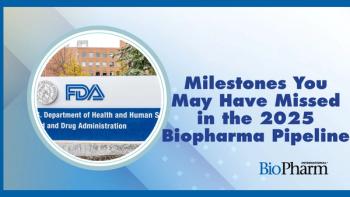
Risks, Resource Strain, and Trade-Offs in FDA’s CNPV Pilot Program
Key Takeaways
- The CNPV program aims to reduce drug review times to 1-2 months, raising concerns about safety and regulatory scrutiny.
- Critics argue that the program may bypass essential review processes and strain FDA resources, impacting other review programs.
Industry experts weigh in on the potential impacts of FDA’s CNPV pilot on safety trade-offs, resource strain, and unclear incentives for sponsors.
Editor's Note:
Stay tuned for additional coverage and industry expert perspectives on how the CNPV program's ultra-fast review forces firms into a parallel execution mode, posting tomorrow. And check out "
The introduction of the FDA Commissioner’s National Priority Voucher (CNPV) pilot program in 2025 has ignited intense debate regarding the balance between speed and scientific rigor in drug review (1-4). The program offers an "unprecedented opportunity to reduce drug and biological product application or efficacy supplement review times from 10-12 months to just 1-2 months" (5,6)(Figure). FDA Commissioner Marty Makary, MD, MPH, championed this effort, calling it a “common-sense approach” that harnesses a "tumor board style" discussion to deliver "more cures and meaningful treatments to the American public” (6). However, experts in public health and regulatory policy (1-4), as well as several industry experts who we spoke with, warn that this acceleration may come at the expense of established safety standards and fiscal responsibility.
How are safety standards and independent regulatory scrutiny affected?
The most significant public health critique comes from those who fear that compressed timelines inherently increase risk. Doctors for America released a statement calling the CNPV program "a very bad idea," with "vague criteria" that "will endanger Americans" (1).
Dr. Robert Steinbrook, Director of Public Citizen Health Research Group, stated definitively: “The priority voucher program is not a ‘common sense’ approach as the FDA Commissioner claims, but a dangerous one” (1). Dr. Steinbrook cited research demonstrating that "when the FDA rushes to review and approve new drugs, there is a higher likelihood that these drugs will have safety problems after approval." He concluded that the CNPV program "will only be a boon for Big Pharma at the expense of the American public."
Furthermore, the fast-track nature is perceived to threaten external review mechanisms. Dr. Steinbrook also noted that the program "will likely bypass the agency’s advisory committee process that allows for outside independent input” (1). Echoing concerns about transparency and patient trust, Dr. Reshma Ramachandran, a member of the Board of Directors of Doctors for America, questioned: “How can patients and clinicians trust that drugs approved with one to two months of review are truly safe and effective?” (1).
What logistical and resource allocation challenges are introduced?
The CNPV challenges FDA’s long-established performance goals under the Prescription Drug User Fee Act (PDUFA), which commits the agency to reviewing priority applications within six months and standard applications within 10 months following the 60-day acceptance period (8). Achieving a consistent one- to two-month timeline necessitates a radical rethinking of resource allocation.
Rory Budihandojo, an independent good manufacturing practices consultant, questions the operational feasibility, stating it is "not clear logistically how the FDA can provide resources needed for this short/intense review without impacting other FDA review programs" in an interview with PharmTech Group. He elaborates that this acceleration "may divert resources from the FDA’s regular standard review program to this expedited review program." This diversion could impact other crucial therapies, including those under the statutory Priority Review Voucher (PRV) program, which "expedite the review to 6 months instead of 10 months."
In a client alert dated Sept 29, 2025, David Dorsey, strategic advisor, and Stephen Holland, senior counsel, both at the law firm Brownstein, noted the logistical challenges of CNPV, stating that FDA’s Center for Drug Evaluation and Research and Center for Biologics Evaluation and Research already "struggle to meet certain PDUFA goals," particularly those related to meetings with sponsors, producing meeting summaries, and responding to follow-up questions within mandated time limits (4). These pre-existing struggles, wrote the authors, are likely to be "aggravated, by the resource needs of the CNPV program"(4).
A significant financial trade-off is the lack of a dedicated funding mechanism, according to Dorsey and Holland. Unlike the statutory PRV programs established by Congress, which require the payment of an "extra user fee on top of any other application fee to provide for the additional resources needed to conduct a priority review…, no similar fee would exist for the CNPV program," they wrote, indicating that this means the entire resource cost must be absorbed internally through reallocation (4).
What are the associated scientific and operational challenges?
To compensate for the compressed review timeline, the CNPV program requires sponsors to submit chemistry, manufacturing, and controls (CMC) information and proposed labeling at least 60 days prior to the formal application filing (5). This front-loading is intended to allow reviewers to begin analysis ahead of submission.
But Dorsey and Holland emphasize that this requirement introduces scientific and procedural challenges. “It is impossible to write and review a drug label without a thorough understanding of all the clinical trial data,” they wrote, adding that pre-submission labeling review may effectively ask reviewers to evaluate claims for which final clinical data are not yet available, “putting the cart before the horse.”
Operationally, the compressed timeline also raises questions about coordinating pre-approval inspections (PAIs), which are required for new products and manufacturing sites. Budihandojo questions whether inspection scheduling could realistically be compressed into the same 1-2-month window.
Aloka Srinivasan, principal and managing partner at Raaha LLC—who has helped a CNPV winner with their application and paperwork and is now getting them ready for the project—adds nuance in an interview with PharmTech Group, stating that for many generics, especially non-complex sterile injectables, CMC work can occur months before filing, leaving bioequivalence as the only major outstanding issue. In such cases, she argues, the CNPV structure may support what is essentially a “first-cycle” approval based on extensive pre-submission interactions.
Still, Srinivasan emphasizes that companies must overhaul their development model to take advantage of the voucher. “The reduction in formal review time does not imply that product development, marketing preparation, or post-approval planning must also be compressed proportionally,” she explains. Instead, organizations must begin market access, pricing, supply-chain qualification, and labeling strategy in parallel with regulatory interactions rather than sequentially.
In an interview with PharmTech Group, Metin Çelik, PhD, president, Pharmaceutical Technologies International, Inc (PTI), summarizes the shift in risk, noting that compressed reviews mean reduced iterative interaction with the FDA, which "places more pressure on a flawless first submission." The result is “more reliance on post-market commitments, including safety studies, registries, or [risk evaluation and mitigation strategy, or REMS] adjustments, because uncertainties cannot be resolved during the short review,” Çelik adds.
What are the sponsor organizational readiness and preparedness differences?
One of the clearest takeaways from the industry experts we spoke with is that the CNPV does not merely test FDA readiness, it tests sponsor readiness. The voucher only benefits companies that enter the process with mature governance systems, integrated quality risk management, strong digital validation capabilities, and robust pre-submission preparation (5).
Henrik Johanning, senior vice president, Quality & Strategy, Epista Life Science notes in an interview with PharmTech Group that compressed timelines “amplify every weakness in a company’s QRM framework.” He explains that risks can easily spill into manufacturing, supply chain, labeling accuracy, or post-market surveillance when iterative review cycles are shortened.
Drawing parallels to COVID-era emergency authorizations, Johanning argues that speed is possible, but only when supported by scalable digital documentation, disciplined cross-functional governance, and deeply integrated CMC and regulatory planning.
Çelik emphasizes that the compressed environment requires “integrated readiness war rooms” and that nearly all manufacturing and supply-chain readiness must be completed before filing. With only 30-60 days for FDA review, “there is no time to fix compliance gaps once the file is submitted,” he warns.
What are the discretion, incentive, and transparency concerns?
The discretionary nature of the CNPV award raises questions about the program’s foundation and ultimate incentives, wrote Dorsey and Holland. The CNPV award is "entirely discretionary and based on largely undefined criteria," they wrote (4).
Budihandojo suggests that the program transparency itself "might be in question; as this is based on the commissioner’s discretion and decision, it may be political based and not just based on science and public need." An industry expert with whom PharmTech Group spoke and who asked to be anonymous, added that attempting to "define and demonstrate the elements" in the program’s parameters, such as to “increase affordability, domesticate manufacturing as a national security issue, or address an unmet public health need,” could be "open to interpretation." Eric Langer, president and managing partner, BioPlan Associates, also notes the "complexity for drug innovators trying to gamble on demonstrating" these elements, in an interview with PharmTech Group.
Dorsey and Holland highlighted that, unlike the statutory PRV programs for which the sponsor knows the criteria and the transferable value (vouchers have recently sold for about $100 million), the CNPV's value as an incentive is questionable (4). Because the award is discretionary and occurs late in development, it is "hard to understand the CNPV as incentivizing anything," especially early development decisions like manufacturing location, they stated (4). The non-transferability (7) and the requirement to use the voucher within two years (7) further limit its appeal, meaning "small biotech companies are less likely to benefit from a CNPV," they added (4).
Despite these risks, FDA Principal Deputy Commissioner Sara Brenner, MD, MPH, maintained confidence, asserting in a news release that the "more efficient process can be achieved without cutting any corners on safety or scientific evaluation” (6). The FDA retains a critical safeguard: the right to extend the review window if data or application components are "insufficient or incomplete," if pivotal trial results are "ambiguous," or if the review is "particularly complex" (5,6).
References
- Doctors for America.
FDA Commissioner’s National Priority Vouchers Will Endanger Americans . Press Release. June 20, 2025. - Eglovitchm, J.
Questions Remain as FDA Opens Submissions for New Priority Voucher Program . RAPS.org. July 24, 2025. - Emond, S; Ollendorf, D.
How to Make One Line in the FDA Commissioner's New Drug Review Program Into a Force for Affordable Access for Patients . Health Aff Sch. 2025;3(10):qxaf182. - Dorsey, D; Holland, S.
A Tale of Three Vouchers . BHFS.com. Sept 29, 2025. - FDA.
Commissioner's National Priority Voucher (CNPV) Pilot Program . Accessed Nov 18, 2025. - FDA.
FDA to Issue New Commissioner’s National Priority Vouchers to Companies Supporting U.S. National Interests . Press Release. June 17, 2025. - FDA.
FAQs: Commissioner’s National Priority Voucher Pilot Program . Accessed Nov 18, 2025.
Newsletter
Stay at the forefront of biopharmaceutical innovation—subscribe to BioPharm International for expert insights on drug development, manufacturing, compliance, and more.





